

Nashville's skyline from the Cumberland River. The peculiar edifice at left is locally called "The Batman Building" for obvious reasons.
We have recently returned from Nashville, Tennessee, where we went to visit some very old friends. They’d lived in the DC area for many years but moved to Music City about 8 months ago to be near their grandchildren. We’d been to Nashville a few years ago to the son’s wedding, but that was a quick in-and-out, so we saw nothing but the lobby of the hotel where the wedding was held; but on this trip we were squired about to see what Nashville has to offer.
Now, many people when they retire “downsize” to a smaller place: not our friends, whose new house is substantially larger than their old one, which was not a small place to begin with. It’s substantially larger than the crummy tar-paper shack in which I force my wife to live, for that matter.
All of the houses in the part of Nashville where they live are large: these days, Realtor™-Speak for a “normal sized” house means a minimum of 4500 to 5000 square feet. It seems that everyone considers himself hard done by if he’s compelled to live in a mere 2500-square-foot, 4-bedroom hovel that—in simpler times—was regarded as ample for a family with four or five children. Five thousand square feet is the “new normal.”
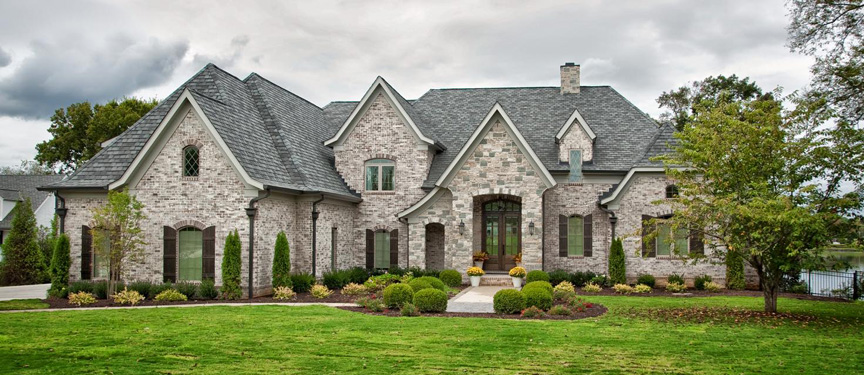
In Nashville many, many houses are much, much larger than that. Seven to eight thousand square feet, easily, in some cases. This would be newly constructed ones, of course: the old plantation houses weren’t anywhere near those pseudo-baronial dimensions. Nor are such homes just owned by country music stars and producers. Our friends are retired, and most of the houses in their spanking-new subdivision are owned by people with run-of-the-mill jobs like lawyers or doctors or some such. The stars live in places so large my friend’s house would likely fit in the garage. The Biltmore Mansion has nothing on some of those homes.

All of the houses, large and “small” have lawns quite literally large enough to land a helicopter on. Maybe the Rescue Squad gets in that way, but whatever the reason, land seems to be cheap enough that a couple of acres of lawn is typical. It makes me ache to think about how much time it takes to keep those endless plains of turf looking like a golf course, but I suppose most of the grunt work is done by hired help. I’m also certain that somewhere in America there is a very comfy padded room in which live the people whose job it is to think up names for suburban subdivisions. Names like “Opal Farms,” “Brendlewood,” “Steeplechase Pointe,” “Brookefielde,” and for all I know, “Anal Retentive Acres.” Our friends’ subdivision is so new it hasn’t yet acquired a name of its own (heck, the street isn’t even on the Google Maps site) at least not one carved onto a slab of bluestone and set in a brick frame at the entrance.
Nashville itself isn’t anything like I thought it would be. The downtown streets are very wide, which again may reflect the relatively low cost of land or it may date to the days when horse-drawn vehicles needed a lot of space to execute a U-turn. Whatever the reason for it, I was surprised by the spaciousness of the streets, especially in downtown. Broadway, the main thoroughfare on which are located the miscellaneous bars (more on this later) is far wider than the real Broadway in New York City.
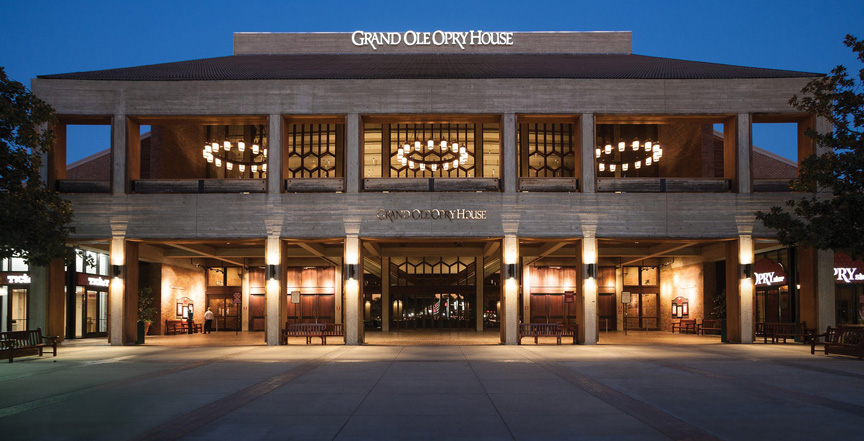
The entrance to the new Grand Ole Opry, at the Gaylord's Opryland complex
Needless to say, we attended a performance at the Grand Ole Opry, Nashville’s iconic and most famous performance venue. The Opry used to be held in downtown at the Ryman Auditorium, which was originally built as a church. The Ryman (it’s always called “The Ryman” in speaking of it) is actually referred to as “The Mother Church Of Country Music.”
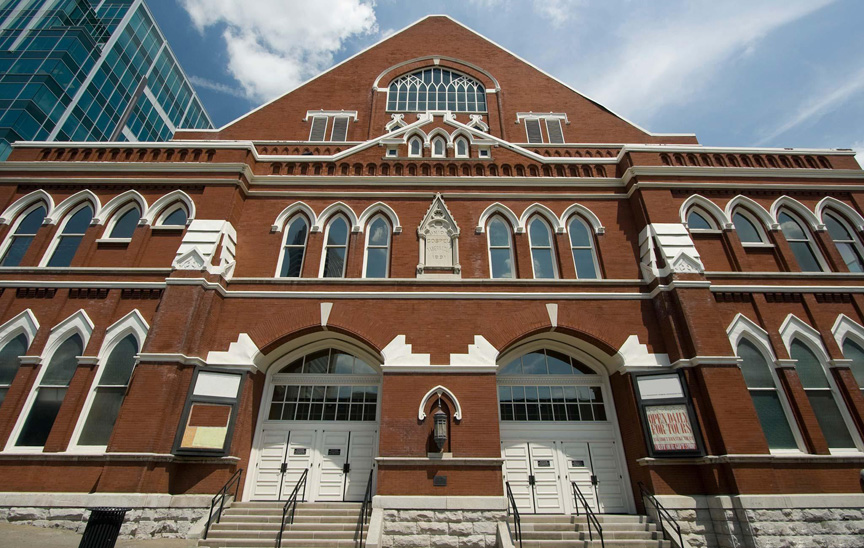
The Mother Church, The Ryman Auditorium
 But about 40 years ago the Opry’s audiences were so large that the show outgrew the Ryman, moving to a purpose-built auditorium in a colossal shopping complex called “Gaylord’s Opryland” that’s located outside the downtown area. Smaller mid-week and winter shows (which draw fewer people) are still held at The Ryman. To ensure continuity of musical tradition, when the new 4400-seat auditorium was built, a circle of wood from the stage at The Ryman was excised and inserted into the Opryland stage. That way “The Circle Was Unbroken,” and performers today stand on it as they do their turns, in homage to those who have gone before.
But about 40 years ago the Opry’s audiences were so large that the show outgrew the Ryman, moving to a purpose-built auditorium in a colossal shopping complex called “Gaylord’s Opryland” that’s located outside the downtown area. Smaller mid-week and winter shows (which draw fewer people) are still held at The Ryman. To ensure continuity of musical tradition, when the new 4400-seat auditorium was built, a circle of wood from the stage at The Ryman was excised and inserted into the Opryland stage. That way “The Circle Was Unbroken,” and performers today stand on it as they do their turns, in homage to those who have gone before.
I’ve always liked country music and bluegrass, but what is called “country music” these days is far different from what it was when I started listening. Today some of it is all but indistinguishable from rock and roll: the beat drives everything, melody is distinctly secondary to rhythm, and it is LOUD. VERY loud, driven by highly-amplified guitars and pounding drums. I can’t express my opinion of this sort of “country music” any better than did George Strait and Alan Jackson in their hit song, “Murder On Music Row.”
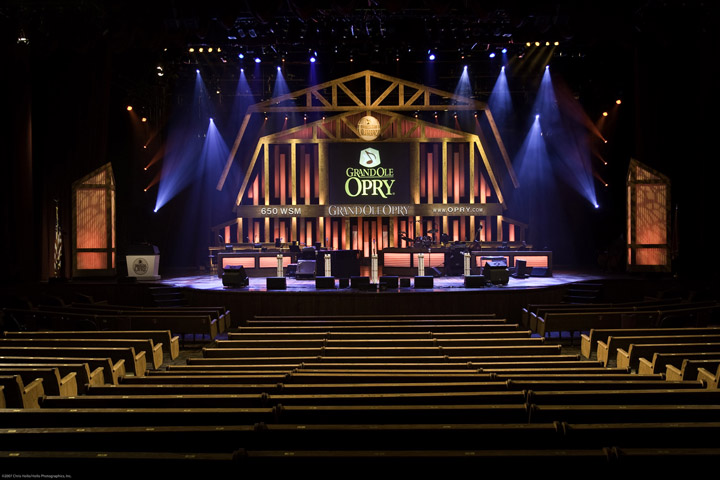
In deference to hidebound, moss-covered traditionalists like me, about a third of the two-hour show was given over to reasonable simulacra of real country music, except that even that included the pounding of drums instead of the throbbing of a bass: and all of it was LOUD. Very loud. Even what Strait and Jackson referred to as “…old time cheatin’ and drinkin’ songs,” ballads of lament and loss, were this way. Of purely acoustic music without electronics and drums, there was none.
Still, we enjoyed the show and got our money’s worth. The audience was worth the price of admission by itself. There were well over 4000 people there, everyone was having a Grand Ole Time at the Grand Ole Opry. The average age was a shade younger than I am, with fair numbers of much younger fans in the crowd. This is a distinct difference from the audiences at the rather more staid performances we go to at the Moss Arts Center here in Blacksburg, where I’m always surprised not to see more people in wheelchairs and pushing walkers than I do.
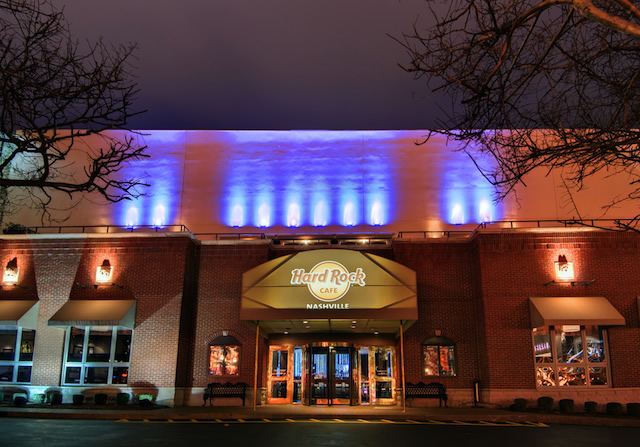
The LOUDEST place we went when we went downtown was the Hard Rock Café. I’d never have gone there but my hosts had a social obligation they couldn’t evade to meet someone there so we went along perforce. Despite the edgy name and the image it apparently strives to convey, I found the Hard Rock Café to be just another LOUD music bar. In some ways it reminded me of the Greenwich Village cafés of my youth. While pretending to be avant-garde and “way out there,” these places—like the Hard Rock Café—really made their money selling hamburgers and ice cream sodas. Once my friends’ obligations were satisfied we left and went to Broadway to watch the tourists.

There are many, many very attractive young visitors in Nashville, who had come to enjoy the music. This was especially true on Broadway, where there are dozens (perhaps hundreds) of small, grubby bars, each with a band playing its collective heart out for tips. We hit a couple of these places, of which the one I liked best had a very good band that did play real country music (albeit amplified and with drums). This band’s pretty girl singer was so pregnant I thought the vibrations of her guitar might send her into labor on the stage. If it had, the audience (most of whom were schnockered) would have taken it in stride, and I’m sure she would have continued to sing between deep breaths and pushing. That band had a very good lead guitarist: when he came around soliciting tips, I complimented him on his playing, and he thanked me in the broadest barely-comprehensible Scottish accent I’ve heard this side of Acorn TV. I knew American country music was very popular in the UK, and this was proof.

Broadway was packed with throngs of tourists, mostly in their 20’s, wandering up and down and hitting as many bars as they could. Any number of them of both sexes were roaming in packs, apparently seeking mates (or at least one-night stands). For someone in that age group, Broadway must be a sort of Happy Hunting Ground. Occasionally one of those large pedal-powered “party cycle” things (where 20 or so people sit along the sides and work bicycle pedals to provide motive power) would come cruising by.

Most of these had been commandeered by parties of drunk girls throwing bachelorette parties, singing loudly and waving their beers as they madly pumped away at the foot pedals. There was a large pick-up truck populated by a dozen or so young men (also clearly feeling no pain) who, I suspect, chose motorized transport to save their energy for later in the evening, after the bachelorettes were pooped and even more thoroughly inebriated. Everyone was having a great time.
Tennessee is a very Second-Amendment-friendly state, and while I have no idea what percentage of Tennesseans have concealed weapon permits, it must be a fair number. The state also recognizes any permit issued by another state, a fact of which I took full advantage: my little Kel-Tec .380 went with me everywhere. That Broadway was not carpeted with the bodies of slain innocents gunned down by the miscellaneous drunks who must have been packing is proof that the Forces Of Darkness are always wrong when they predict doom if concealed carry laws are liberalized or (as in some other states) completely abolished.
 The musicians who perform in the venues along Broadway are hoping to be “discovered” and eventually to sign a recording contract with one of the big production companies (or even a smallish one) whose offices are on Music Row. Music Row is a wide divided boulevard near downtown, with modest buildings on either side housing the studios. It looks a good deal more like I expected Nashville to look: a quiet-tree-lined street with signs for companies whose business is discovering, shepherding, and making colossal amounts of money from, songs. Like a Mafia neighborhood in Brooklyn, it’s unostentatious and unimaginably wealthy.
The musicians who perform in the venues along Broadway are hoping to be “discovered” and eventually to sign a recording contract with one of the big production companies (or even a smallish one) whose offices are on Music Row. Music Row is a wide divided boulevard near downtown, with modest buildings on either side housing the studios. It looks a good deal more like I expected Nashville to look: a quiet-tree-lined street with signs for companies whose business is discovering, shepherding, and making colossal amounts of money from, songs. Like a Mafia neighborhood in Brooklyn, it’s unostentatious and unimaginably wealthy.
Music is everywhere in Nashville—and I do mean everywhere—but we did see other things. One day we went to The Parthenon. This is a full-sized replica of the famous Greek Temple set in Centennial Park. The difference is that the Greek version is a ruin but the Nashville one isn’t. When Nashville had its Centennial celebration in the 1890’s their Parthenon was built along with other neo-classical revival buildings: that was a period when Greek Revival was the style for civic edifices. The buildings were supposed to be temporary, but the Parthenon proved popular enough that the city decided to keep it. By the 1920’s the crumbling plaster façade was so badly deteriorated that it had to be restored and replaced with a concrete one,  while maintaining the look of the building. Today the Parthenon is an
while maintaining the look of the building. Today the Parthenon is an  art museum, highlighting paintings from the collection of one of its benefactors. On its upper level is a gigantic statue of Athena, done in 1990. The statue, over 40 feet high, is a scholarly copy of the original that once stood in the Greek Parthenon. Anyone looking for Culture in Nashville need look no farther than Centennial Park.
art museum, highlighting paintings from the collection of one of its benefactors. On its upper level is a gigantic statue of Athena, done in 1990. The statue, over 40 feet high, is a scholarly copy of the original that once stood in the Greek Parthenon. Anyone looking for Culture in Nashville need look no farther than Centennial Park.
Of course there is Culture and there is Culture. One other Cultural Venue we went to was Parnassus Books. This store is partly owned by one Ann Patchett, a moderately-famous-within-her-sphere American authoress. Her Wikipedia entry, after the usual biographical details, includes this passage:
In 2010, when she found that her hometown of Nashville no longer had a good book store, she co-founded Parnassus Books…the store opened in November 2011. In 2012, Patchett was on the Time 100 list of most influential people in the world by TIME magazine. She is a vegan for "both moral and health reasons."
 It should be obvious from this passage what Parnassus Books is all about. You can take your pick of Vegan cookbooks, very Left-of-Center political books, books about The Oppression Of Women By Men, books about the importance of The Environment, books about The Menace Of Global Warming, etc., etc., etc., ad infinitum. In Parnassus Books you will not find tomes on how to build bomb shelters, but rather screeds on The Importance Of Getting In Touch With Your Feelings so that you can Give Peace A Chance and realize that really, All You Need is Love. There are books about how to grow silkworms in your organic garden to Help Foster A Sustainable World. You will not find any copies of Gun Digest but you certainly can find plenty of books on Why Guns Are Bad. No biographies of George Washington—who was of course a slave owner—but there are plenty of biographies of Che Guevara, John Lennon, and that other, less well-known, Lenin, Vladimir Ilyitch. Ms Patchett took good care that her home town finally had a GOOD bookstore, and made damned sure that only GOOD books were sold there. Or else.
It should be obvious from this passage what Parnassus Books is all about. You can take your pick of Vegan cookbooks, very Left-of-Center political books, books about The Oppression Of Women By Men, books about the importance of The Environment, books about The Menace Of Global Warming, etc., etc., etc., ad infinitum. In Parnassus Books you will not find tomes on how to build bomb shelters, but rather screeds on The Importance Of Getting In Touch With Your Feelings so that you can Give Peace A Chance and realize that really, All You Need is Love. There are books about how to grow silkworms in your organic garden to Help Foster A Sustainable World. You will not find any copies of Gun Digest but you certainly can find plenty of books on Why Guns Are Bad. No biographies of George Washington—who was of course a slave owner—but there are plenty of biographies of Che Guevara, John Lennon, and that other, less well-known, Lenin, Vladimir Ilyitch. Ms Patchett took good care that her home town finally had a GOOD bookstore, and made damned sure that only GOOD books were sold there. Or else.
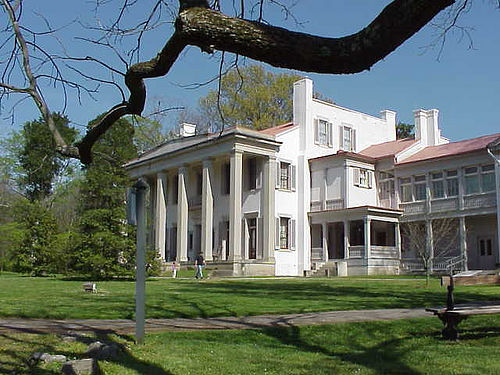 One day was devoted to History, and on that day we visited Belle Meade Plantation. This was originally a 5400-acre self-sustaining horse farm, but is now reduced to a paltry 30 acres and has become a state park. Belle Meade was famous for its race horses and the races they won: the pretty docent who showed us around was careful to point out that every horse that has run in the Kentucky Derby for the past 9 years—winners as well as losers—can trace its lineage back to a single horse bred and owned at Belle Meade. And
One day was devoted to History, and on that day we visited Belle Meade Plantation. This was originally a 5400-acre self-sustaining horse farm, but is now reduced to a paltry 30 acres and has become a state park. Belle Meade was famous for its race horses and the races they won: the pretty docent who showed us around was careful to point out that every horse that has run in the Kentucky Derby for the past 9 years—winners as well as losers—can trace its lineage back to a single horse bred and owned at Belle Meade. And 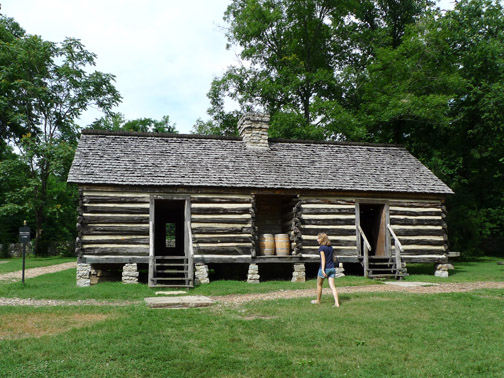 that famous horse (whose name I’ve forgotten) was raised and trained by a black man who was given to the owners of Belle Meade at the age of 3 months as a wedding present; his labor became the source of the wealth of Belle Meade’s owners. The Belle Meade mansion is a high point of the tour, but there is also the obligatory exhibit of the slave cabins and the working quarters to drive home the point. Needless to say, the owners of Belle Meade were on the losing side in the Civil War; while the Old Master donated enough money to raise and equip an entire artillery regiment, a fat lot of good that did him. Belle Meade seems to have been fairly typical of the huge estates that existed in Nashville in the 19th Century, all the rest of which seem to have been turned into subdivisions with names like “Planter’s Meadowe” and “Cardinal Forest.”
that famous horse (whose name I’ve forgotten) was raised and trained by a black man who was given to the owners of Belle Meade at the age of 3 months as a wedding present; his labor became the source of the wealth of Belle Meade’s owners. The Belle Meade mansion is a high point of the tour, but there is also the obligatory exhibit of the slave cabins and the working quarters to drive home the point. Needless to say, the owners of Belle Meade were on the losing side in the Civil War; while the Old Master donated enough money to raise and equip an entire artillery regiment, a fat lot of good that did him. Belle Meade seems to have been fairly typical of the huge estates that existed in Nashville in the 19th Century, all the rest of which seem to have been turned into subdivisions with names like “Planter’s Meadowe” and “Cardinal Forest.”

History Day included a quick run through downtown Franklin, a city of what is usually called "quiet Southern Charm," at least in downtown. The town square has a statue of a Confederate soldier (and I pity the poor schlunk from the federal government who tries to take that down: as I said, Tennessee is very Second-Amendment friendly...) ringed by cannon that likely would still fire in a pinch. We stopped at another bookstore, though it wasn't one that was Politically Correct. Rather it was one of the sort that is opened by a retired university professor and (if he's lucky) breaks even selling used books to browsing tourists.

The "Secret City," Oak Ridge, in 1945. This is the Y-12 Plant area where atom bomb components were made.
On the way home we stopped at Oak Ridge, possibly one of the least Politically Correct cities in the USA. The purified uranium and the plutonium that powered the atomic bombs that ended World War Two were made there and it was a nerve center for the Manhattan Project. There’s a museum there that documents the growth of “The Secret City” (Oak Ridge was so secret it didn’t appear on maps until well after the war) and the lives and work of the people who built the bomb components and refined the isotopes.
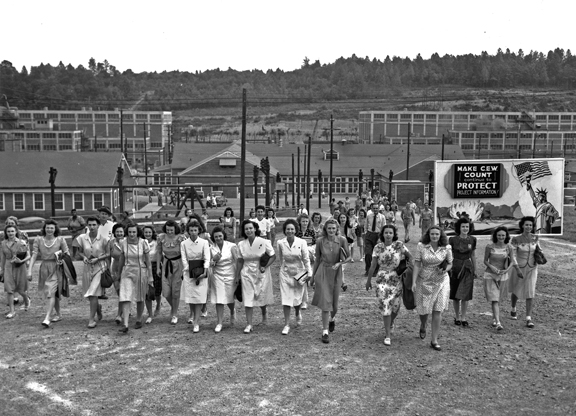
The Babes Who Built The Bomb: shift change at the Y-12 plant. The workers there were supposedly unaware of what they were making, but it's a pretty safe bet most of them were smart enough to figure out pretty much what it was intended to do.
The museum is very thorough in its coverage, having among its exhibits one of the original “flat top” pre-fabricated houses that were put up for married workers. These were about 576 square feet, and so well built that many of them are still standing and in use. At one time the government could do things right.

A 576-Square Foot "Flat Top" house. Many of these are still in use as homes!
After Oak Ridge we headed back to I-40 and home. The total round trip was a shade under 900 miles, and we were pooped when we got home. But Nashville has been on the Bucket List for some time, so it was a worthwhile trip.
| HUNTING | GUNS | DOGS |
| FISHING & BOATING | TRIP REPORTS | MISCELLANEOUS ESSAYS |
| CONTRIBUTIONS FROM OTHER WRITERS|
| RECIPES |POLITICS |